One summer day I killed 3 ants in my kitchen. I did it again the next day and the next. By the fourth day, I realized that killing the ants I saw wasn’t working. I did some observing and discovered that they were coming in through the corner under my outside door.
There are two main ways to keep ants out of your house. You can get rid of existing ants and you can repel them from coming inside again. You will also want to decide if you want to kill the colony or try and just repel them. If you catch them soon enough, repelling the scouts might work, but if you already have a lot of ants in your house, then repelling them could break the colony into multiple sub-colonies and make the problem worse.
Plus, if the ants in your house are carpenter ants, then you have bigger problems than the ants you have actually seen. This article will cover how to tell the difference between house and carpenter ants and how to get rid of both kinds! That includes natural and commercial solutions.
How To Tell The Difference Between A Carpenter Ant And A House Ant
The two most common types of ants to invade your house are carpenter ants and house ants. Odorous ants are also called pavement ants or odorous ants. Some people call them sugar ants, but sugar ants are different.
You will want to use different treatment methods depending on which type of ant you have.
Carpenter ants are larger than house ants. They are usually ¼ to ½ inches long. They tunnel through wet and damaged wood and nest in it. They can also cause permanent damage to your home if left untreated.
Carpenter ants won’t tunnel through healthy wood. If they did, then maybe they wouldn’t cause as much damage. Instead, they eat through wet and damaged wood. This means that the parts of your house already at risk for permanent damage are being further damaged by the ants.
One of the surest signs of carpenter ants is small piles of fine sawdust. This identifies places where the ants are tunneling through. You may see signs close to water sources since the wood has to be wet.
Keep an eye on areas close to water. Carpenter ants are attracted to water. Check pipes for leaks under sinks. Watch windows for condensation or water leaks from the outdoors. Drains and shower basins are also places where ants may be attracted.
There are different methods to get rid of carpenter ants versus regular pavement ants. First, let’s discuss ways to get rid of common pavement ants and then we’ll talk about carpenter ants.
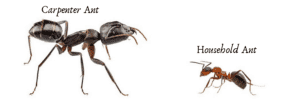
25 Ways To Get Rid Of House Ants
There are many ways to get rid of odorous ants, but simply killing the one or two ants you first see isn’t usually the best method. That’s because there are usually a lot more ants in the house than the few that are initially visible.
First, you will want to get rid of the ants in your home and then you can take steps to repel them and keep them away. There are a lot of home remedies to keep ants away, as well as natural ant killers.
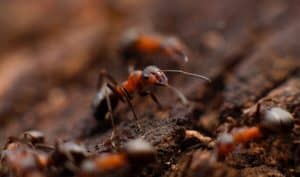
1. Keep Ants Off Your Picnic Table With Water
Picnic tables often have ants nearby. That’s because the leftover crumbs and spills attract them. Constant use of picnic tables in parks makes ants pretty common when you go to eat.
You can keep the ants away from your picnic table by bringing along empty dishes. Use Tupperware, pie tins, or even large metal cans. Put the legs of the picnic table in the containers and fill them with water.
The water will drown the ants when they try to get to the picnic table. This works well with the standard picnic tables but isn’t as effective with the metal ones whose legs have runners along the ground because it’s hard to create a “moat” for the ants.
2. Find Out What’s Attracting The Ants
Ants are usually after a food source or water. Since water is usually rampant outside, they usually come inside for food. Ants crave either sugary foods or proteins.
Their tastes vary throughout the year. In the springtime, they are usually attracted to proteins. This is why they are often attracted to flour and to meats. In the summer, they are more attracted to sugars. You can test which types of food they are going after by creating a bait station.
Place a plate with both sweet food and protein-based food and watch which one the ants prefer. You can use sugar-based foods such as fruits or protein based foods such as peanut butter, meats, sausage, jerky or flour as a bait.
This will help you to better bait them.

Carpenter Ant with varying colors
3. Resist Killing Individual Ants And Instead Work Toward Elimination
Instead of killing the ants you see, allow them to find the bait station and communicate the food source to the colony. This will ensure a better eradication of your indoor ants. If you kill the visible ants, then you miss the other hidden ants.
Worker ants communicate food sources to the colony so killing the workers just means that more workers will continue coming for the food. Since ant colonies can have millions of workers, your ant problem continues.
Instead, use baits to kill ant colonies. There are several natural baits you can set up.
4. Create A Sugar And Borax Bait Station To Kill The Ants
Most of the time, ants are attracted to sugar. So if you want to skip testing which types of foods are attracting your ants, the sugar bait station is a good one to start with.
There are two ways to create a sugar bait station.
Mix A Wet Bait Station: 1 part borax with 3 parts sugar. Add just enough water to make a paste about the consistency of syrup. Borax is poisonous to ants and will kill them. By adding enough more sugar than borax, you will attract the ants and they won’t smell the borax.
Place the bait station in the area where you see the ants and allow the worker ants to grab the food and carry it back to the colony. This will bring more worker ants but will kill the colony as they consume it.
Worker ants can’t eat what they carry. They usually go back, feed the food to the larvae and then eat the byproduct of the babies. As a result, all the stages of the ant colony are killed with a bait station like this.
Consider using plastic containers with small holes punched in. This will keep pets and kids from finding and consuming. Borax can be harmful to people and animals if consumed. The holes will allow the worker ants inside and out.
Mix A Dry Bait Station: Powdered Sugar and Baking Soda
Mix half baking soda and half powdered sugar. Place the bait in the ant’s trail. This provides a dry bait station for the worker ants to find and carry the poison back to the colony. The powdered sugar masks the smell of the baking soda.
You can also mix powdered sugar and borax together for another effective solution. Just make sure to put it in an area where pets and kids won’t have access.

4. Create A Protein-Based Bait Station
If your ants don’t seem interested in the sugar bait station, then you can create a protein-based one to kill them. Simply mix 1 Tablespoon peanut butter with 1 Tablespoon sugar. This will make the PB smell sweeter. That makes it a great trap for both sugar craving and protein craving ants.
Then, mix in 1 teaspoon of borax into the peanut butter. Please in the path of the worker ants.
5. Eliminate Other Food Attractions
When you see ants, do a heavy cleaning of the areas affected by the ants. Spilled flour, sugar, or spices can attract ants. Some spices attract ants and others repel them.
Check the corners of your pantry for missed spills and food remnants. Wipe down your cookbooks and check your cupboards.
Clean under the fridge and stove. These places often have food crumbs and other spills that attract ants.
Even doing something as simple as sweeping after eating or cooking can help to keep from attracting ants into your house.
6. Seal All Food In Airtight Containers
Put all your open food items in sealed containers. Containers with tight-fitting lids will keep ants away from your food items. Honey and syrup can have drips down the container, which attracts ants.
These types of containers should be kept in a ziplock bag to keep the smell from attracting ants.
7. Check House Plants For Aphids.
Aphids are more common than you think for house plants. They can leave behind a tiny white scaly flake on the leaves of your plants.
Tropical house plants are the most susceptible to aphids.
That substance is sweet to ants and they like to eat it. Get rid of aphids by adding an aphid stick to your soil. This will kill the aphids on your
Aphids excrete a sweet substance that ants will eat. Kill the aphids on your plants and it will stop the attraction for ants. Indoor aphids are particularly common in tropical house plants. Wipe of leaves or treat plants for aphids.
Then wipe the leaves of your plants to clean off the scales remains.
8. Destroy Ants Pheromone Scent Trails
Ants leave a pheromone trail. This scent trail tells them where to go. You can test this pheromone trail by spraying vinegar on a line of ants. They will scatter as they lose their scent.
Scent trails are the way that ants can keep finding their way back into your house or pantry.
Clean the area to wipe away the pheromone. Several home remedies are most effective for repelling ants and for masking or eliminating their scent trails.
These remedies include things like garlic, lemons, vinegar, or peppermint. Other remedies don’t allow ants to leave a scent trail and so they tend to avoid those substances.
This includes things like chalk, talcum, and coffee grounds. Let’s cover them in greater detail.

9. Watch Where The Ants Are Entering Your Home
Ants can come into a home in many ways. Try to observe the worker ants to see if you can figure out how they are coming it. If you can’t figure it out then check outside your home.
Watch for traces of ants. Check for ant hills and areas with ants around the home.
You will be more effective it you can eliminate ants from inside your house before you create a barrier to keep them out.
That’s because if you have a lot of ants inside your home and you create an ant barrier, it can cause your pants to sub colonize inside your home. They won’t be willing to cross the barrier to get outside again.
But, once, you have eliminated recent activity with ants through bait stations, consider these other steps so that you can keep future worker ants out of your house.
10. Eliminate Pheromone Trails With Vinegar
Vinegar is probably the most universal and the most effective cleanser that will safely kill and get rid of ants scent trails. It has a strong odor that covers the pheromones and cleanses effectively.
It is also safe for animals and people.
Simply mix 1 part vinegar to 1 part water and spray around the area where ants have been coming into your house. This eliminates the path they have been following and ants tend to avoid vinegar.
Wipe it clean with a dry clean cloth or let it air dry.
Another option is to add a few drops of dish soap into a bottle of half vinegar and half water. The dish soap helps to clean.
I have heard that as little as 1 part vinegar to 1 part water is effective. I haven’t tried it because vinegar is such a cheap option that I’d rather use the full solution and have it be more effective.
11. Use Chalk To Create A Barrier Around Your House
The main ingredient in chalk is Calcium Carbonate. Calcium Carbonate is made up of crushed sea shells and other shells of marine animals. Ants don’t like it (as well as a lot of other bugs).
Some people recommend that simply drawing a chalk line around your house will be effective, but this is deceptive. Most chalk is too small and the lines to narrow to be effective for ants.
Instead, you can purchase calcium carbonate in powder form. You could also buy the jumbo sidewalk chalk.
Sprinkle it to create a solid barrier all the way around your house. The powdered calcium carbonate will go over dirt, lawn and not just a cement or blacktop. You can also apply it easier and faster than a chalk line, which requires bending over or getting on your hands and knees. I like to use this hand duster to dust calcium carbonate or powdered chalk around an area.
The ants don’t like to cross the chalk because it disrupts their pheromone trails and they cant feel with their feet when they walk through it.
Spray the chalk into corners and areas where you suspect ants are getting into your house.

12. Use Talcum Powder Instead Of Calcium Carbonate
If you don’t have any chalk and don’t want to purchase any calcium carbonate, then consider sprinkling baby powder around the area. Talcum powder is the main ingredient in baby powder and drives ants away.
Just like calcium carbonate, it plugs ants’ ability to sense and taste through their feet. It confuses them and they don’t like to travel through it.
But, be careful because talcum is dangerous to breathe. So if you apply it with the hand duster, be sure to wear a mask so you aren’t breathing it. It will settle out of the air in a few minutes. You can also minimize breathing it by applying it close to the ground.
13. Use Salt To Create A Barrier
Salt can be used in place of talc or chalk. Fine salt creates a barrier much better than coarse salt. You will need to put a line of salt around the area the ants are getting in.
Salt can kill plants and is bad for the soil so be careful about using a lot of it outdoors. It can affect your landscaping overtime.
14. Get Rid Of Ant Hills With Water And Cayenne
There are several ways that you can use water to get rid of ant hills. If you want a more peaceful solution, simply flood the ant hill daily until the ants have moved on.
A faster way is to boil water and add a lot of cayenne pepper or vinegar to the water. Pour the boiling water into the ant hill. Be sure to saturate it. The boiling water will kill the ants on impact and the cayenne pepper or vinegar will destroy the scent of ants.
This will keep the worker ants from coming home and rebuilding. Don’t use on fire ant hills. There are other methods more effective and the fire ants can recolonize quickly. Keep reading for fire ant solutions!
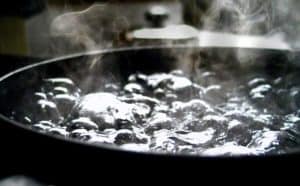
15. Seal Entry Points And Fix Siding
Try to find out where the ants are getting in. Once you discover how they are getting in, you can seal the cracks and crevices where they enter. Use a silicone-based sealant for greater wear and longer lasting effects.
You can also add natural and cheap repellents to keep them out.
Another best practice is to keep your siding at least 3-6 inches above ground level. When siding touches the ground, it creates a perfect environment for bugs and ants to get in under the siding. From there, it is easy and common for them to make their way into the house.
Instead, trim siding so that it is several inches above ground level.
- Fix entry points
- Seal cracks with silicone
- Use repellents to discourage ants from coming in through entry points
17. Use Effective Landscaping When Possible
Some types of landscaping invite ants and other pests into the house. Climbing ivy and roses create a bridge that allows insects in. It makes it possible for ants to climb up your house and to find any entry point, not just those near the ground.
Pay particular attention to anywhere that vegetation touches your house. If you can, trim back bushes, trees, and shrubs so that there are at least 6 inches of space between the plants and the outside of your house.
This will help to create a barrier between the bugs and you.
Another thing you can do is to use rocks as a ground cover instead of mulch. Mulch creates an ideal environment for bugs to grow, hide, and nest. It is more inviting for ants. Rocks create a much harsher environment for the same pests.
- Keep silent at least 3-6 inches higher than the ground level
- Use rocks in your landscaping instead of mulch
- Keep bushes, trees, and vegetation trimmed back away from the house
18. Use A Variety Of Kitchen Herbs To Repel Ants
There are many kitchen herbs than you can use that repel ants. Most of them are very strong in scent and will cover up the pheromone trails left by ants.
Bay leaves are a strongly scented herb. You can use them among your flour, sugar and other food attractants to repel ants. THey are also strong enough to repel other pests. You will need to replace them monthly to keep them potent and strong smelling.
Cinnamon will also repel ants. Sprinkle it near entry points or other problem areas. The ants will go away from a cinnamon barrier.
Garlic is super strong. Use fresh garlic in areas of concern. As the garlic dries up, replace it to keep it potent and effective.
You can also pour pepper around and into an ant hill to push the colony elsewhere. The strong scent is abhorrent to ants.
- Bay Leaves
- Cinnamon
- Garlic
- Pepper
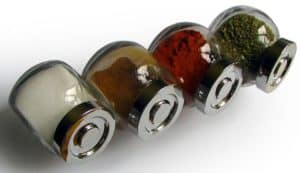
19. Peppermint Essential Oil Repels Ants
Peppermint is very strong and smells good to most people. It’s strong scent also repels many bugs, including ants.
Instead of spreading it out, soak cotton balls in peppermint oil.
Place the cotton balls in the areas where ants have congregated. It will cover the scent trails.
20. Use Coffee Grounds As A Pheromone Cover
Coffee grounds are strong and don’t cost anything extra if you are a coffee drinker. Just sprinkle them around outside areas where you have any problems. The strong scent will repel the ants and they will move on.
Use it around ant hills. You can also spread it around the foundations of your house to discourage intruders.
This solution works as a great outdoors solution and you can use it in the garden and flowerbeds to keep ants away.
21. Citrus Smell Repels Ants
Lemons and oranges are both strong smelling and will repel ants. That’s because citrus oil strips away the protective gat that ants have around them to keep them safe.
You can slice lemons and leave them in problem areas. This will cover the scent trails left by other worker ants and discourage other ants from coming into an area.
Orange peels can be blended with water and poured over ant hills. I don’t think it will kill the ants, but it will cause an evacuation of the colony.

22. Vaseline Clogs Their Sense Of Feel And Smell
Ants tell a lot about their environment and food source through their sense of feel in their feet. Their antennas also taste their food. As a result, smearing vaseline around an area will keep ants out.
The vaseline plugs their sensors and confuses the ant. They will avoid the area diligently.
23. Use Bifenthrin For Fire Ants
Bifenthrin is used primarily to get rid of fire ants. You can get it in granules or concentrated liquid form. It can remain in the soil for up to 8 months, depending on the type of soil.
It can also be toxic so be careful when using it. Don’t use more than you need and don’t scatter haphazardly. If animals eat it, it will cause harm.
24. Tempo Insecticide Is A Safer Commercial Option
Tempo is a chemical ant killer. It also kills a lot of other stuff. But, it is safer for kids and pets. As soon as it dries, it is non-toxic.
Spray it around the perimeter of your house. Spray your windows, door frames, and roof eaves. You can even safely spray it indoors along your walls and vents. Just make sure that kids and pets are away until it dries.
It is very effective and I haven’t tried other commercial options because I haven’t needed to.
25. Be Patient And Wait A Few Days
It will take a few days for your worker ants to carry the bait back to the colony. It takes time to consume the food and for it to kill the colony. Be patient as it may take up to 4 or 5 days before it starts working.
For very large colonies, it can take as long as a couple of weeks for ant baits to be effective. Some colonies have multiple queens or are so large that it takes a lot of time for worker bees to carry enough poison back.
Watch your ant activity for signs that it is slowing down. Don’t jump to another solution if you see ants only a couple of days after trying a solution.
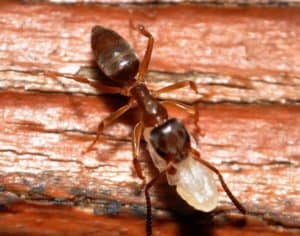
Worker Ants Moving Larvae
How To Get Rid Of Carpenter Ants
Carpenter ants are more difficult to get rid of because they don’t take food back to the colonies. So you can’t use a bait station and effectively get rid of the colony.
Instead, you have to find the colony and kill it at the location.
Often this means tearing into your walls to find the carpenter ants. It can seem like a lot of work, but the rotten wood should be replaced anyway. Since carpenter ants don’t tunnel through healthy wood, they only expose existing issues that already need fixing.
Fix all your water leak problems. Stop the cause of the damage.
Pull out the wet walls to find the colony.
Realize that sometimes carpenter ants will have a satellite colony in your house and another main colony outside. The satellite colony is used to transport resources outside.
Carpenter ants are more common around wooded areas.

You can kill carpenter ants by sprinkling diatomaceous earth (DE) around the colony. It is super sharp for ants and will slice them apart. The colony will dehydrate and die.
You can also use a bulb duster to insert it into the holes around the colony and nest.
Or you can mix it with 2 tablespoons DE to 1-quart water. Spray it around the area of the ants.
Use a baster or bulb duster to insert it into the holes around the carpenter ant nest.
Carpenter ant baits work by getting poison on the ants. Even though carpenter ants don’t carry food back, they will pick up the bait. When they groom themselves, it will poison and kill them.
Boric acid kills ants. It acts as a stomach poison. Mix 1 part sugar with 2 parts boric acid. Put it in bottle caps in areas where the ants’ trail. They will carry it back to the nest.
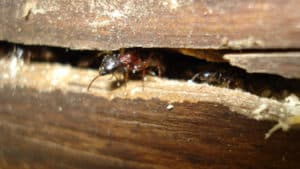
-
-
- Tear into the walls to eliminate the colony at its source
- Fix all the leaks and water issues in the house
- Understand that there may be satellite colonies
- Diatomaceous Earth kills carpenter ants
- Borax is Poisonous to Carpenter Ants
- Commercial Bait kills the colony but takes a few weeks
-
How To Tell The Difference Between A Carpenter Ant and A Termite
Many people confuse carpenter ants with termites. Some pest control specialists even say that most “carpenter ant” problems are actually termite problems.
While carpenter ants don’t eat the wood, they only tunnel through it, termites do eat wood. They will also tunnel through healthy wood while carpenter ants only go through rotted and wet wood.
Carpenter ants clean and polish the gallery of their tunnels so it looks clean and polished. Termites don’t. Their galleries will appear dirty, clogged, and have soil throughout.
Visually termites and carpenter ants look different.
Carpenter ants have pinched wastes while termites have a single body. Termites have even wings while carpenter ants have a second pair of wings that are much shorter than the front pair.
The antenna of ants is segmented and the antenna of termites is straight in a single section.
Carpenter ants are usually visible in the home while termites usually remain unspotted.
- Carpenter ants have a narrow waist
- Termites have equal wing length while ants have hind wings that are shorter
- Termites have dirty tunnels while ants have polished galleries
- Carpenter ants have bent antennas while termites have straight antennae

Kill Fire Ants With Effective Home Remedies
There are a lot of “remedies” on how to kill fire ants. One of the one I see the most is the “drown” method. While drowning or flooding out regular ants can be an effective way to cause colonies to relocate, it’s not a good method with fire ants.
Fire ants can swim. So dumping a ton of water into their anthill will only make them angry and cause them to attack.
Another remedy is to use dichotomous earth to kill them. DE will kill them, but it will be very difficult to get it deep enough to kill the queen. Unless the queen is killed, the colony will survive as the queen only needs a few worker ants to start a new colony.
But, there are some remedies that work well.

Orange Oil Kills Fire Ants
Orange oil destroys the protective coating that fire ants have around their bodies. Use it to kill the ant colony.
You will need enough orange oil to saturate the ant hill and get it down to the queen bee. You will only need to use 1-2 ounces of oil per gallon of water. That’s about ⅛ of a cup of orange oil.
Fire ants won’t cross an orange oil barrier so the first thing you will want to do is to pour a complete circle around the ant hill. This will keep the ants contained in the ant hill.
Next, saturate the ant hill with the orange oil. You may need several gallons to fully saturate a large anthill. You will see the fire ants crawl out and by the next day, you won’t see much activity left.
Borax Kills Fire Ants
Borax kills fire ants. It’s also safe for the environment. Mix 1 parts borax and 3 parts sugar. Sprinkle it around the ant hill and place bait stations around the area. Check out the full description earlier in the article.
References
[post-carousel id=”364″]


